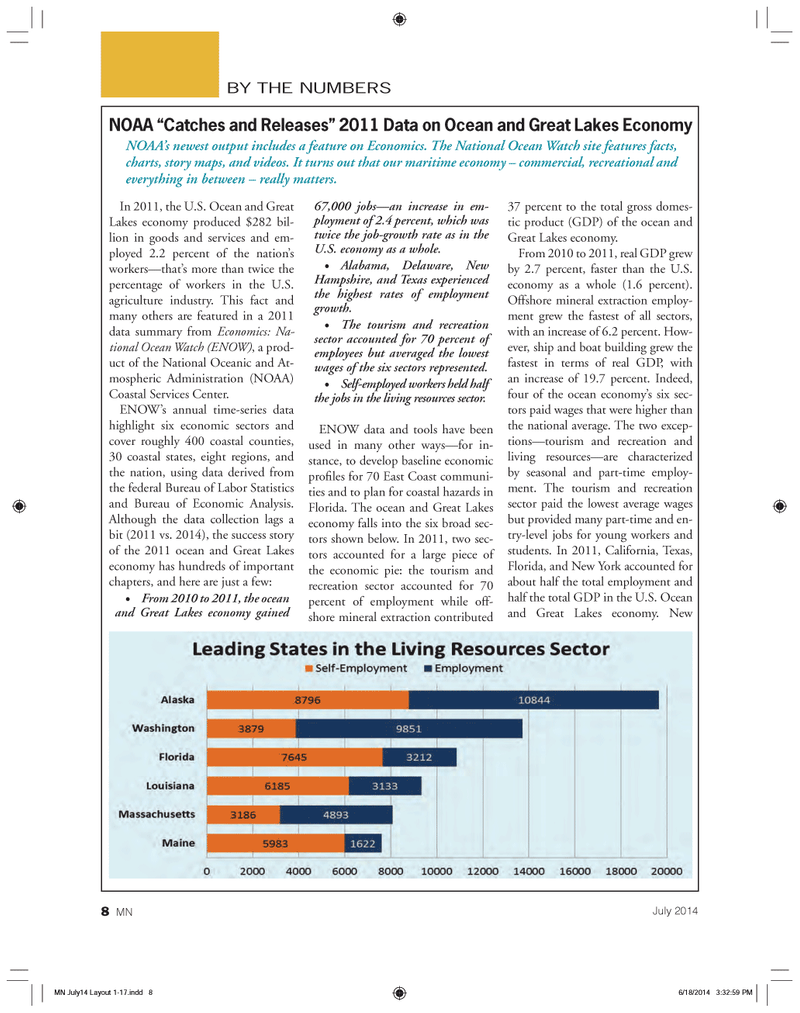
Page 8: of Marine News Magazine (July 2014)
ATB Technical Trends
Read this page in Pdf, Flash or Html5 edition of July 2014 Marine News Magazine
BY THE NUMBERSIn 2011, the U.S. Ocean and Great Lakes economy produced $282 bil- lion in goods and services and em- ployed 2.2 percent of the nation?s workers?that?s more than twice the percentage of workers in the U.S. agriculture industry. This fact and many others are featured in a 2011 data summary from Economics: Na- tional Ocean Watch (ENOW) , a prod- uct of the National Oceanic and At- mospheric Administration (NOAA) Coastal Services Center. ENOW?s annual time-series data highlight six economic sectors and cover roughly 400 coastal counties, 30 coastal states, eight regions, and the nation, using data derived from the federal Bureau of Labor Statistics and Bureau of Economic Analysis. Although the data collection lags a bit (2011 vs. 2014), the success story of the 2011 ocean and Great Lakes economy has hundreds of important chapters, and here are just a few: From 2010 to 2011, the ocean and Great Lakes economy gained 67,000 jobs?an increase in em- ployment of 2.4 percent, which was twice the job-growth rate as in the U.S. economy as a whole. Alabama, Delaware, New Hampshire, and Texas experienced the highest rates of employment growth. The tourism and recreation sector accounted for 70 percent of employees but averaged the lowest wages of the six sectors represented. Self-employed workers held half the jobs in the living resources sector. ENOW data and tools have been used in many other ways?for in-stance, to develop baseline economic pro les for 70 East Coast communi- ties and to plan for coastal hazards in Florida. The ocean and Great Lakes economy falls into the six broad sec- tors shown below. In 2011, two sec- tors accounted for a large piece of the economic pie: the tourism and recreation sector accounted for 70 percent of employment while off- shore mineral extraction contributed 37 percent to the total gross domes- tic product (GDP) of the ocean and Great Lakes economy. From 2010 to 2011, real GDP grew by 2.7 percent, faster than the U.S. economy as a whole (1.6 percent). Offshore mineral extraction employ- ment grew the fastest of all sectors, with an increase of 6.2 percent. How- ever, ship and boat building grew the fastest in terms of real GDP, with an increase of 19.7 percent. Indeed, four of the ocean economy?s six sec- tors paid wages that were higher than the national average. The two excep- tions?tourism and recreation and living resources?are characterized by seasonal and part-time employ- ment. The tourism and recreation sector paid the lowest average wages but provided many part-time and en- try-level jobs for young workers and students. In 2011, California, Texas, Florida, and New York accounted for about half the total employment and half the total GDP in the U.S. Ocean and Great Lakes economy. New NOAA ?Catches and Releases? 2011 Data on Ocean and Great Lakes Economy NOAA?s newest output includes a feature on Economics. The National Ocean Watch site features facts, charts, story maps, and videos. It turns out that our maritime economy ? commercial, recreational and everything in between ? really matters. 8 MNJuly 2014MN July14 Layout 1-17.indd 8MN July14 Layout 1-17.indd 86/18/2014 3:32:59 PM6/18/2014 3:32:59 PM

 7
7

 9
9
